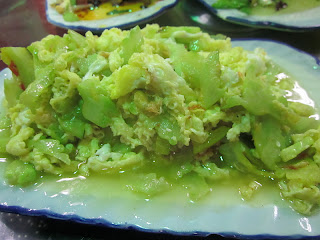We have finally reached Lhasa! Yay! Carrying my heavy luggage, I walked real slow, afraid that I may just pass out due to the high altitude. And true enough, even with quick steps, I was having difficulty in breathing. It was terrible. I was taking quick breaths in. Puffing to walk towards the escalator.
This is how the train station look like inside. I was told to hurry up as I snapped the photos.
Outside the train station, I saw military officers around the area. I thought that this was a very heavily-guarded area. I wanted to snap a photo of the train station and an officer yelled at me. When I looked back, he was staring at me. Hmph!
So, we crossed the road, and took the full view of the train station. We waited for our bus.
That year, Tibet celebrated its 60 years of being part of China.
In the bus, we were given white scarves as a welcome gift. White scarves are symbolic and suppose to mean good luck. In the bus, the tour guide was not there, but her cousin was there instead. He explained to us that places that are military guarded do not allow snapshots.
It was just a 20 minute bus ride from the train station to our place of stay. We passed by the new city of Lhasa.
Upon reaching the old Lhasa town, the bus stopped and we had to walk to our hotel. It was just less than 5 minutes.
We stayed at Mandala Hotel. Nice place with beautiful carvings and colours! At that moment, I just loved Lhasa for its lovely colours!
After checking in, we walked around the town. We were told not to bathe on our first day, due to the change in altitude. The street we stayed on is Barkhor Square. Many stalls filled the place, selling beautiful trinkets.
While walking, I didn't understand the significance of the actions the people were doing. My initial thoughts were that they were praying. But I didn't understand who were they praying to. At my later part of the trip, the tour guide explained to us the significance of their praying method.
The Tibetans are making full-length prostrations towards the monastery. Also, it's a form of yoga exercise which is good for the digestive system.
How it is done: Stand up. Place palms together. Put the palms at your forehead (which means focus to Buddhism only), then down to the mouth (speak good words), then to the heart (purify your mind). Kneel down. Push body full-length forward. Arms straight out. Get up at the knee and then stand up. Do it again.
As we approached closer to the building in the building, I realised it was a monastery. I was exposed to my first monastery - Jokhang Monastery, a UNESCO Heritage Site. A holy place, and one of the places that Tibetans must go to before they die.
The Tibetans walk clock-wise around the monastery (the monastery is in the middle of the old city of Lhasa) and carry a prayer wheel while walking, chanting 'Om Mani Padme Hum'. The tour guide explained the following day - Prayer wheels are used to accumulate wisdom and merit (good karma) and to purify negativities (bad karma). The wheel must be turned clock-wise. The wheel contains Buddha scriptures. There are many scriptures in Tibetan Buddhism, and these scriptures are summarised in these 6 characters - Om Ma Ni Pad Me Hum.
We also found out later that this is a prayer flag. The higher the prayer flag, the better, as the blessings can be carried to all. The prayer flags comes in 5 colours to represent the 5 elements - Blue : sky/space, white : air/wind, red : fire, green : water, and yellow : earth.
We found a place to eat. It was a good dinner, having not eaten rice for the past 2 days, surviving on instant noodles only.

You know what is great about these chopsticks? There were not woody strands coming out, like how the chopsticks are in Malaysia. It was so smooth.

After dinner, we walked back to our place. The place looks lovely at night too.

I felt safe walking the streets in Lhasa.
As if 'Buddhism' was enveloping me.













































No comments:
Post a Comment